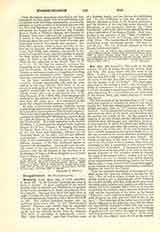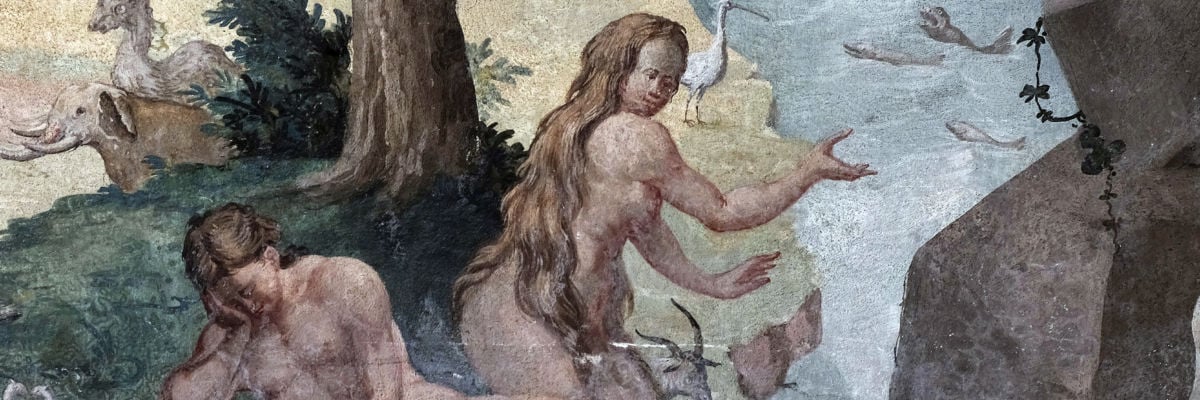

Eve (Heb. CHWH, hawwah).—The name of the first woman, the wife of Adam, the mother of Cain, Abel, and Seth. The name occurs only five times in the Bible. In Gen., iii, 20, it is connected etymologically with the verb CHYH or CHWH, “to live”: “And Adam called the name of his wife Eve [CHWH, hawwah]: because she was the mother of all the living”. The Septuagint rendering in this passage is Zoe (=life, or life-giver), which is a translation; in two other passages (Gen., iv, 1 and 25) the name is transliterated Eu a. The Biblical data concerning Eve are confined almost exclusively to the second, third, and fourth chapters of Genesis (see Adam).
The first account of the creation (Gen. i, “P”) sets forth the creation of mankind in general, and states simply that they were created male and female. The second narrative (Gen., ii, “J”) is more explicit and detailed. God is represented as forming an individual man from the slime of the earth, and breathing into his nostrils the breath of life. In like manner the creation of the first woman and her relation to man is described with picturesque and significant imagery. In this account, in which the plants and animals appear on the scene only after the creation of man, the loneliness of the latter (Gen., ii, 18), and his failure to find a suitable companion among the animals (Gen., ii, 20), are set forth as the reason why God determines to create for man a companion like unto himself. He causes a deep sleep to fall upon him, and taking out one of his ribs, forms it into a woman, who, when she is brought to him, is recognized at once as bone of his bone and flesh of his flesh. A discussion of the arguments in favor of the historical, or the more or less allegorical character of this narrative would be beyond the scope of the present notice. Suffice it to say that the biblical account has always been looked upon by pious commentators as embodying, besides the fact of man’s origin, a deep, practical and many-sided significance, bearing on the mutual relationship established between the sexes by the Creator.
Thus, the primitive institution of monogamy is implied in the fact that one woman is created for one man. Eve, as well as Adam, is made the object of a special creative act, a circumstance which indicates natural equality with him, while on the other hand her being taken from his side implies not only her secondary role in the conjugal state (I Cor., xi, 9), but also emphasizes the intimate union between husband and wife, and the dependence of the latter on the former “Wherefore a man shall leave father and mother, and shall cleave to his wife: and they shall be two in one flesh.” The innocence of the newly created couple is clearly indicated in the following verse, but the narrator immediately proceeds to relate how they soon acquired, through actual transgression, the knowledge of good and evil, and with it the sense of shame which had been previously unknown to them. In the story of the Fall, the original cause of evil is the serpent, which in later Jewish tradition is identified with Satan (Wisdom, ii, 24). He tempts Eve presumably as the weaker of the two, and she in turn tempts Adam, who yields to her seduction. Immediately their eyes are opened, but in an unexpected manner. Shame and remorse take possession of them, and they seek to hide from the face of the Lord.
For her share in the transgression, Eve (and woman-kind after her) is sentenced to a life of sorrow and travail, and to be under the power of her husband. Doubtless this last did not imply that the woman’s essential condition of equality with man was altered, but the sentence expresses what, in the nature of things, was bound to follow in a world dominated by sin and its consequences. The natural dependence and subjection of the weaker party was destined inevitably to become something little short of slavery. But if woman was the occasion of man’s transgression and fall, it was also decreed in the Divine counsels, that she was to be instrumental in the scheme of restoration which God already promises while in the act of pronouncing sentence upon the serpent. The woman has suffered defeat, and infinitely painful are its consequences, but henceforth there will be enmity between her and the serpent, between his seed and her seed, until through the latter in the person of the future Redeemer, who will crush the serpent’s head, she will again be victorious.
Of the subsequent history of Eve the Bible gives little information. In Gen., iv, 1, we read that she bore a son whom she named Cain, because she got him (QNH—to acquire, possess) through God—this at least is the most plausible interpretation of this obscure passage. Later she gave birth to Abel, and the narrative does not record the birth of another child until after the slaying of Abel by his elder brother, when she bore a son and called his name Seth; saying: “God hath given me [SYT—put or appoint] another seed, for Abel whom Cain slew”. Of daughters no specific mention is made in this account, but in Gen., v, 4 (“P”) we find the general statement that “the days of Adam, after he begot Seth, were eight hundred years: and he begot sons and daughters”.
Eve is mentioned in the Book of Tobias (viii, 8; Sept., viii, 6) where it is simply affirmed that she was given to Adam for a helper; in II Cor., xi, 3, where reference is made to her seduction by the serpent, and in I Tim., ii, 13, where the Apostle enjoins submission and silence upon women, arguing that “Adam was first formed; then Eve. And Adam was not seduced, but the woman being seduced, was in the transgression”.
As in the case of the other Old Testament personages, many rabbinical legends have been connected with the name of Eve. They may be found in the “Jewish Encyclopedia“, s.v. (see also, Adam), and in Vigouroux, “Dictionnaire de la Bible“, I, art. “Adam“. They are, for the most part, puerile and fantastic, and devoid of historical value, unless in so far as they serve to illustrate the mentality of the later Jewish writers, and the unreliability of the “traditions” derived from such sources, though they are sometimes appealed to in critical discussions.
JAMES F. DRISCOLL


